机械工程专业英语教程(第2版)[施平主编][翻译]_lesson19
- 格式:pdf
- 大小:88.96 KB
- 文档页数:3
![机械工程专业英语教程(第2版)[施平主编][翻译]_lesson1](https://uimg.taocdn.com/5728f673a417866fb84a8e09.webp)
Basic Concept in MechanicsThe branch of scientific analysis which deals with motions , time , and forces is called mechanics and is made up of two parts , statics and dynamics , Statics deals with the analysis of stationary systems , i.e. , those in which time is not a factor , and dynamics deals with systems which change with time .对运动、时间和作用力做出科学分析的分支称为力学。
它由静力学和动力学两部分组成。
静力学对静止系统进行分析,即在其中不考虑时间这个因素,动力学对随时间而变化的系统进行分析。
When a number of bodies are connected together to form a group or system , the forces of action and reaction between any two of the connecting bodies are called constraint forces . These forces constrain the bodies to behave in a specific manner . Forces external to this system of bodies are called applied forces .当一些物体连接在一起形成一个组合体或者系统时,任何两个相连接的物体之间的作用力和反作用力被称为约束力。
这些力约束着各个物体,使其处于特定的状态。
从外部施加到这个物体的系统的力被称为外力。
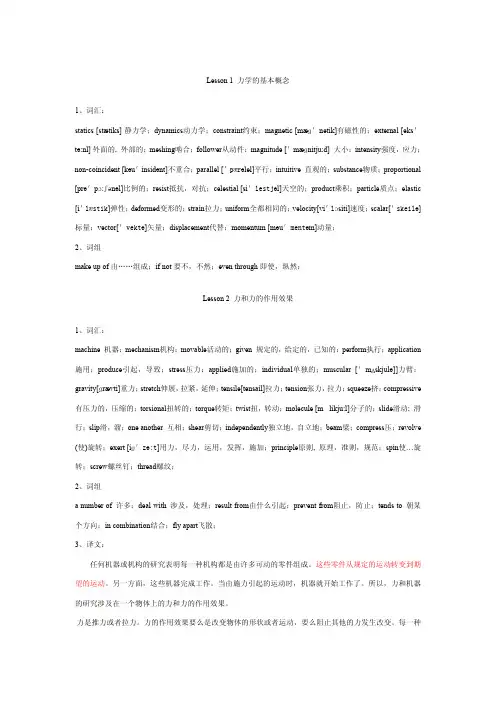
Lesson 1 力学的基本概念1、词汇:statics [stætiks] 静力学;dynamics动力学;constraint约束;magnetic [mæɡ'netik]有磁性的;external [eks'tə:nl] 外面的, 外部的;meshing啮合;follower从动件;magnitude ['mæɡnitju:d] 大小;intensity强度,应力;non-coincident [kəu'insidənt]不重合;parallel ['pærəlel]平行;intuitive 直观的;substance物质;proportional [prə'pɔ:ʃənəl]比例的;resist抵抗,对抗;celestial [si'lestjəl]天空的;product乘积;particle质点;elastic [i'læstik]弹性;deformed变形的;strain拉力;uniform全都相同的;velocity[vi'lɔsiti]速度;scalar['skeilə]标量;vector['vektə]矢量;displacement代替;momentum [məu'mentəm]动量;2、词组make up of由……组成;if not要不,不然;even through即使,纵然;Lesson 2 力和力的作用效果1、词汇:machine 机器;mechanism机构;movable活动的;given 规定的,给定的,已知的;perform执行;application 施用;produce引起,导致;stress压力;applied施加的;individual单独的;muscular ['mʌskjulə]]力臂;gravity[ɡrævti]重力;stretch伸展,拉紧,延伸;tensile[tensail]拉力;tension张力,拉力;squeeze挤;compressive 有压力的,压缩的;torsional扭转的;torque转矩;twist扭,转动;molecule [m likju:l]分子的;slide滑动; 滑行;slip滑,溜;one another 互相;shear剪切;independently独立地,自立地;beam梁;compress压;revolve (使)旋转;exert [iɡ'zə:t]用力,尽力,运用,发挥,施加;principle原则, 原理,准则,规范;spin使…旋转;screw螺丝钉;thread螺纹;2、词组a number of 许多;deal with 涉及,处理;result from由什么引起;prevent from阻止,防止;tends to 朝某个方向;in combination结合;fly apart飞散;3、译文:任何机器或机构的研究表明每一种机构都是由许多可动的零件组成。
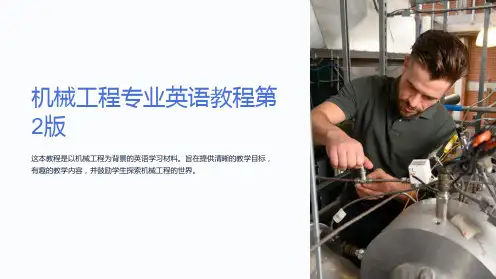
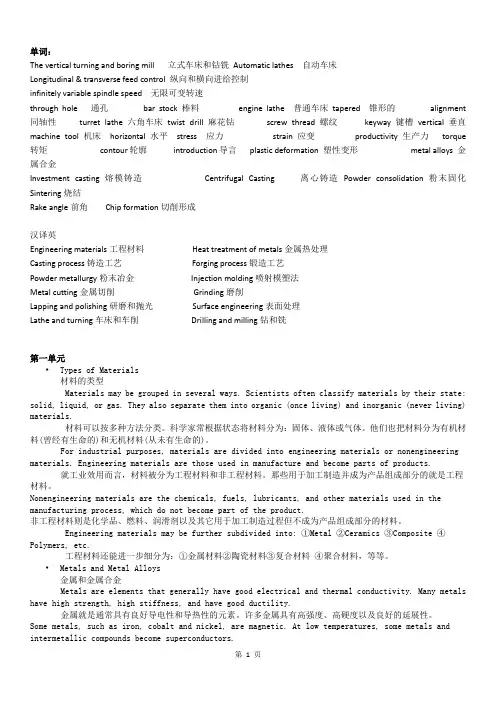
单词:The vertical turning and boring mill 立式车床和钻铣Automatic lathes 自动车床Longitudinal & transverse feed control 纵向和横向进给控制infinitely variable spindle speed 无限可变转速through hole 通孔bar stock 棒料engine lathe 普通车床tapered 锥形的alignment 同轴性turret lathe 六角车床twist drill 麻花钻screw thread 螺纹keyway 键槽vertical 垂直machine tool 机床horizontal 水平stress 应力strain 应变productivity生产力torque 转矩contour轮廓introduction导言plastic deformation 塑性变形metal alloys 金属合金Investment casting 熔模铸造Centrifugal Casting 离心铸造Powder consolidation粉末固化Sintering烧结Rake angle前角Chip formation切削形成汉译英Engineering materials工程材料Heat treatment of metals金属热处理Casting process铸造工艺Forging process锻造工艺Powder metallurgy粉末冶金Injection molding喷射模塑法Metal cutting金属切削Grinding磨削Lapping and polishing研磨和抛光Surface engineering表面处理Lathe and turning车床和车削Drilling and milling钻和铣第一单元•Types of Materials材料的类型Materials may be grouped in several ways. Scientists often classify materials by their state: solid, liquid, or gas. They also separate them into organic (once living) and inorganic (never living) materials.材料可以按多种方法分类。
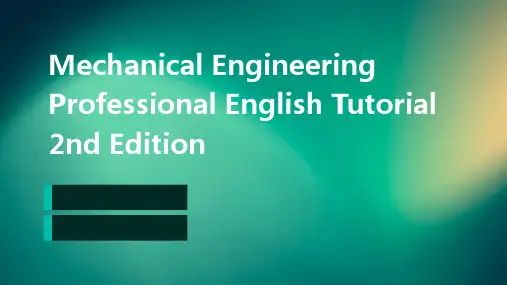

![机械工程专业英语教程(第2版)[施平主编][翻译]_lesson12](https://uimg.taocdn.com/52120369b84ae45c3b358c09.webp)
Spur GearsGears , defined as toothed members transmitting rotary motion from one shaft to another , are among the oldest devices and inventions of man . In about 2600 B.C. , the Chinese are known to have used a chariot incorporating a complex series of gears . Aristotle , in the fourth century B.C. , wrote of gears as if they were commonplace . In the fifteenth century A.D. , Leonardo da Vinci designed a multitude of devices incorporating many kinds of gears .齿轮,在最古老的设备和发明人中,被定义为通过轮齿将旋转运动从一根轴传递到另一根轴,大约在公元前2600年,中国人就知道用战车组成一系列复杂的齿轮系。
西元前四世纪,亚里士多德记述了齿轮就好像是他们司空见惯的一样。
在十五世纪,达芬奇设计了大量的包含各种各样齿轮的设备。
Among the various means of mechanical power transmission (including primarily gears , belts , and chains ) , gears are generally the most rugged and durable . Their power transmission efficiency is as high as 98 percent . On the other hand , gears are usually more costly than chains and belts . As would be expected , gear manufacturing costs increase sharply with increased precision -- as required for the combination of high speeds and heavy loads , and for low noise levels . ( Standard tolerances for various degrees of manufacturing precision have been established by the AGMA , American Gear Manufacturers Association. )在众多的机械传动方式中(包括齿轮传动,带传动,链传动),一般来说,齿轮是最经久耐用的,它的能量传递效率高达98%。
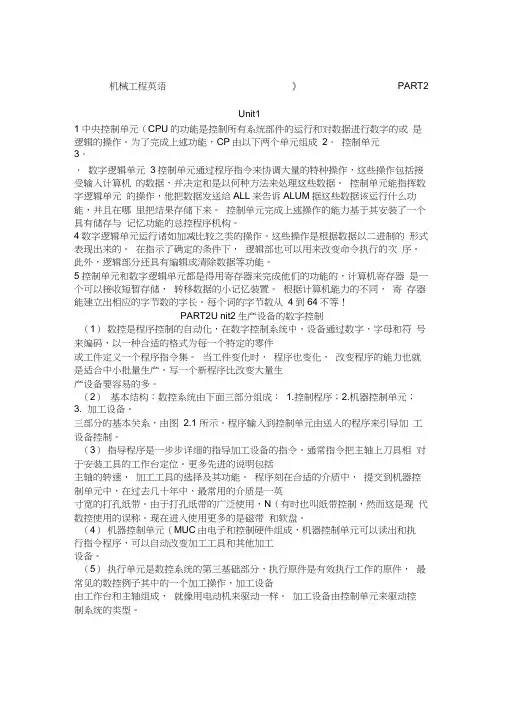
机械工程英语》PART2Unit11中央控制单元(CPU的功能是控制所有系统部件的运行和对数据进行数字的或是逻辑的操作。
为了完成上述功能,CP由以下两个单元组成2.控制单元3..数字逻辑单元3控制单元通过程序指令来协调大量的特种操作,这些操作包括接受输入计算机的数据,并决定和是以何种方法来处理这些数据。
控制单元能指挥数字逻辑单元的操作,他把数据发送给ALL来告诉ALUM据这些数据该运行什么功能,并且在哪里把结果存储下来。
控制单元完成上述操作的能力基于其安装了一个具有储存与记忆功能的总控程序机构。
4数字逻辑单元运行诸如加减比较之类的操作。
这些操作是根据数据以二进制的形式表现出来的。
在指示了确定的条件下,逻辑部也可以用来改变命令执行的次序。
此外,逻辑部分还具有编辑或清除数据等功能。
5控制单元和数字逻辑单元都是得用寄存器来完成他们的功能的,计算机寄存器是一个可以接收短暂存储,转移数据的小记忆装置。
根据计算机能力的不同,寄存器能建立出相应的字节数的字长。
每个词的字节数从4到64不等!PART2U nit2生产设备的数字控制(1)数控是程序控制的自动化,在数字控制系统中,设备通过数字,字母和符号来编码,以一种合适的格式为每一个特定的零件或工件定义一个程序指令集。
当工件变化时,程序也变化,改变程序的能力也就是适合中小批量生产。
写一个新程序比改变大量生产设备要容易的多。
(2)基本结构:数控系统由下面三部分组成: 1.控制程序;2.机器控制单元;3. 加工设备。
三部分的基本关系,由图 2.1 所示。
程序输入到控制单元由送入的程序来引导加工设备控制。
(3)指导程序是一步步详细的指导加工设备的指令。
通常指令把主轴上刀具相对于安装工具的工作台定位。
更多先进的说明包括主轴的转速,加工工具的选择及其功能。
程序刻在合适的介质中,提交到机器控制单元中,在过去几十年中,最常用的介质是一英寸宽的打孔纸带。
由于打孔纸带的广泛使用,N(有时也叫纸带控制,然而这是现代数控使用的误称。
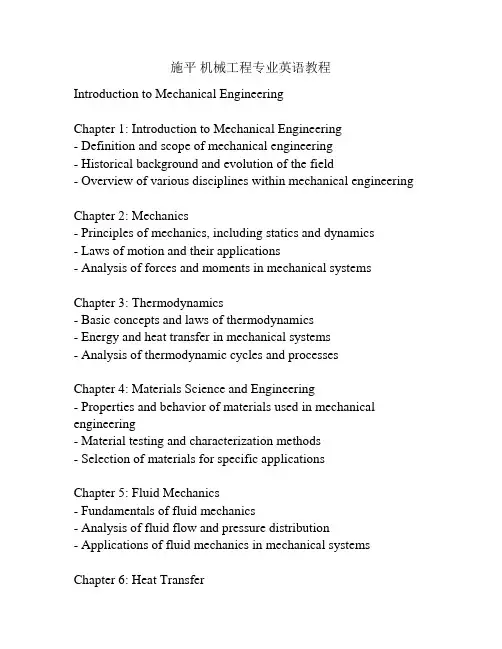
施平机械工程专业英语教程Introduction to Mechanical EngineeringChapter 1: Introduction to Mechanical Engineering- Definition and scope of mechanical engineering- Historical background and evolution of the field- Overview of various disciplines within mechanical engineering Chapter 2: Mechanics- Principles of mechanics, including statics and dynamics- Laws of motion and their applications- Analysis of forces and moments in mechanical systems Chapter 3: Thermodynamics- Basic concepts and laws of thermodynamics- Energy and heat transfer in mechanical systems- Analysis of thermodynamic cycles and processesChapter 4: Materials Science and Engineering- Properties and behavior of materials used in mechanical engineering- Material testing and characterization methods- Selection of materials for specific applicationsChapter 5: Fluid Mechanics- Fundamentals of fluid mechanics- Analysis of fluid flow and pressure distribution- Applications of fluid mechanics in mechanical systems Chapter 6: Heat Transfer- Modes of heat transfer (conduction, convection, radiation)- Heat transfer analysis and calculations- Applications of heat transfer in mechanical systemsChapter 7: Energy Conversion and Power Systems- Energy conversion principles and devices- Analysis of power generation systems- Renewable energy sources and sustainabilityChapter 8: Machine Design and Control Systems- Design principles and methodologies for mechanical systems- Control systems and automation in mechanical engineering- Analysis and optimization of machine componentsChapter 9: Manufacturing Processes- Various manufacturing processes and methodologies- Machining, forming, casting, and joining processes- Quality control and inspection in manufacturingChapter 10: Engineering Ethics and Professionalism- Ethical considerations in engineering practice- Professional responsibility and accountability- Society and the engineer's role in sustainable development Chapter 11: Career Opportunities in Mechanical Engineering- Overview of career options and paths in mechanical engineering - Skills and qualities desired by employers- Professional organizations and resources for career advancement Chapter 12: Emerging Technologies in Mechanical Engineering- Trends and developments in the field of mechanical engineering - Introduction to advanced technologies like robotics, nanotechnology, and artificial intelligence- Potential impact of these technologies on the future of mechanical engineering.。
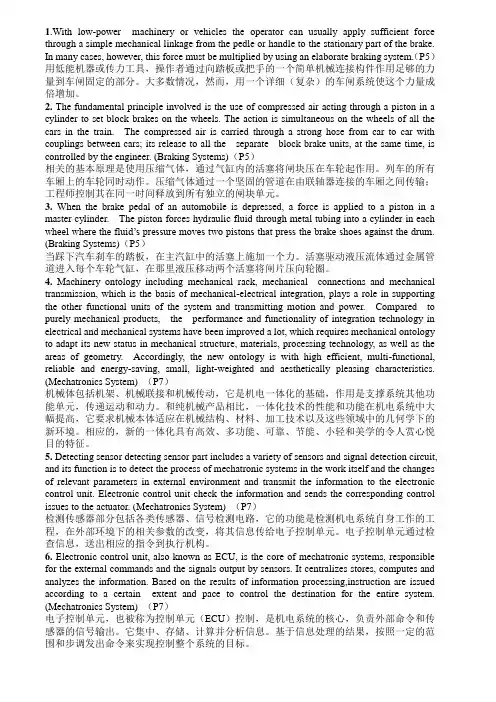
1.With low-power machinery or vehicles the operator can usually apply sufficient force through a simple mechanical linkage from the pedle or handle to the stationary part of the brake. In many cases, however, this force must be multiplied by using an elaborate braking system.(P5)用低能机器或传力工具,操作者通过向踏板或把手的一个简单机械连接构件作用足够的力量到车闸固定的部分。
大多数情况,然而,用一个详细(复杂)的车闸系统使这个力量成倍增加。
2. The fundamental principle involved is the use of compressed air acting through a piston in a cylinder to set block brakes on the wheels. The action is simultaneous on the wheels of all the cars in the train. The compressed air is carried through a strong hose from car to car with couplings between cars; its release to all the separate block brake units, at the same time, is controlled by the engineer. (Braking Systems)(P5)相关的基本原理是使用压缩气体,通过气缸内的活塞将闸块压在车轮起作用。
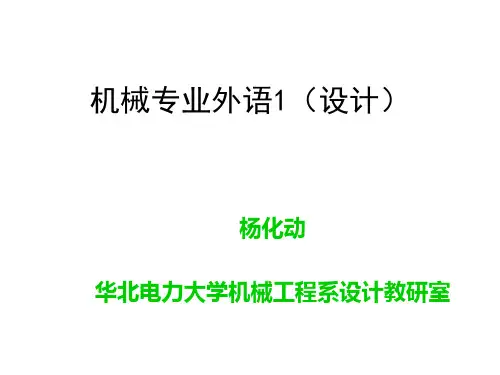
机械工程专业英语》参考译文高等学校机械设计制造及其自动化专业新编系列教材(供教师及学生使用)黄运尧黄威司徒忠李翠琼武汉理工大学出版社目录编译者的话………………………………第1章材料和热加工…………………第1课机械学的基本概念…………第2课塑性理论的基本假设………第3课有限元优化的应用…………第4课金属…………………………第5课金属和非金属材料…………第6课塑料和其他材料……………第7课模具的寿命和失效…………第8踩冷加工和热加工……………第9踩铸造…………………………第10课制造中的金属成形工艺…第11课缎选………………………第12课锻造的优点和工作原理…第13课焊接………………………第14课热处理……………………第二章机构和机器原理……………。
第15课机构介绍…………………。
第16课运动分析………………….第l7课运动的综合………………—第18课凸轮和齿轮………………—第19课螺纹件,紧固件和联接件—第20课减(耐)摩擦轴承…………*第2l课斜齿轮、蜗杆蜗轮和锥齿轮第22课轴、离合器和制动器……—第三章机床………第23课机床基础第24课车床……第25课牛头刨、钻床和铣床…………第36课磨床和特种金属加工工艺……第四章切削技术和液压“………………第27课加工基础………………………第28课基本的机械加工参数…………第29课切削参数的改变对温度的影响第30课刀具的磨损…………第31课表面稍整加工机理…第32课极限和公差…………“第33课尺寸控制和表面桔整”第34课自动央具设计………“第36课变速液压装置……………—…………—策37课电液伺服系统…………。
……………。
第五章机械电子技术………………………………第38课专家系统……。
…………………………第3D课建筑机器人………………………………第40课微机为基础的机器人模拟………………第41课机器人学的定义和机器入系统…………第42课微型计算机基础(1)……………………第43课微型计算机基础(x)……………………第44课可编程控制器……………………………第45课CAD/CAM计算机辅助设计与制造…第46课计算机数控和直接数控,CNC和DNC第47课加工过程的数控—………………………第48课柔性制造系统……………—……………第仍课交互式编程系统…………………………第50课在振动分析方面的计算机技术…………策51课压力传感器………………………………第52课反馈元件…………………—……………第53课现代按制理论概述………………………第54课管理上采取了新的措施—来自福持汽第六章英文科技文献和专利文献的查阅…………6.1 常见科技文献及其查阅………………………6.2 专利文献概述…………………………………第七章英文科拉论文写作…………………………7.1 标题与摘要写法………………………………7.2 正文(body)的组织与写法…………………7.3 致谢、附录及参考文献………………—……参考文献………………………………………………第1章材料和热加工机械学的基本概念功是力乘以该力作用在物体上佼物体移动的距离。
目录1·2·7·8·11·12单元第一单元? Types of Materials材料的类型Materials may be grouped in several ways. Scientists often classify materials by their state: solid, liquid, or gas. They also separate them into organic (once living) and inorganic (never living) materials.材料可以按多种方法分类。
科学家常根据状态将材料分为:固体、液体或气体。
他们也把材料分为有机材料(曾经有生命的)和无机材料(从未有生命的)。
For industrial purposes, materials are divided into engineering materials or nonengineering materials. Engineering materials are those used in manufacture and become parts of products.就工业效用而言,材料被分为工程材料和非工程材料。
那些用于加工制造并成为产品组成部分的就是工程材料。
Nonengineering materials are the chemicals, fuels, lubricants, and other materials used in the manufacturing process, which do not become part of the product.非工程材料则是化学品、燃料、润滑剂以及其它用于加工制造过程但不成为产品组成部分的材料。
Engineering materials may be further subdivided into: ①Metal ②Ceramics ③Composite ④Polymers, etc.工程材料还能进一步细分为:①金属材料②陶瓷材料③复合材料④聚合材料,等等。
Gear Materials (Reading Material)齿轮材料(阅读材料)Gears are manufactured from a wide variety of materials, both metallic as well as nonmetallic.齿轮由多种种类的材料制造,包括金属材料和非金属材料。
As is the case with all materials used in design, the material chosen for a particular gear should be the cheapest available that will ensure satisfactory performance.在设计中可以使用多种材料的情况下,对于特定齿轮,应当做到选用满足使用要求下的最便宜的材料。
Before a choice is made, the designer must decide which of several criteria is most important to the problem at hand.在作出选择前,设计师必须决定在众多设计准则中哪个是当前最重要的。
If high strength is the prime consideration, a steel should usually be chosen rather than cast iron.如果高强度是第一要考虑的因素,通常就选择钢材而不选择铸铁。
If wear resistance is the most important consideration, a can be made, for problems involving noise reduction, nonmetallic. Materials perform better than metallic ones.如果耐磨性是最重要的因素,可以选用非金属材料要比金属材料更好,同时也可以解决降低噪声的问题。
第 2 次课的教学整体安排2.教学内容与讨论、思考题、作业部分可合二为一。
2 Lubrication润滑Although one of the main purposes of lubrication is to reduce friction, any substance –liquid, solid, or gaseous—capable of controlling friction and wear between sliding surfaces(滑动表面) can be classed as (定义为)a lubricant.Varieties of lubricationUnlubricated(无润滑) sliding. Metals that have been carefully treated to remove all foreign materials(异物) seize and weld to one another when slid together. In the absence of(如果没有) such a high degree of cleanliness, adsorbed(吸附的) gases, water vapor, oxides(氧化物), and contaminants (杂质)reduce friction and the tendency to seize but usually result in severe wear, this is called “unlubricated” or dry sliding (干滑动).Fluid-film(流体膜) lubrication.Interposing a fluid film that completely separates the sliding surfaces results in fluid-film lubrication. The fluid may be introduced intentionally as the oil in the main bearing(主轴承) of an automobile, or unintentionally, as in the case of water between a smooth rubber tire(橡胶轮胎) and a wet pavement(路面). Although the fluid is usually a liquid such as oil, water, and a wide range of other materials, it may also be a gas. The gas most commonly employed is air.To keep the parts separated, it is necessary that the pressure within the lubrication film balance(与…保持平衡) the load on the sliding surfaces. If the lubricating film’s pressure is supplied by an external source, the system is said to be lubricated hydro-statically(静压地). If the pressure between the surfaces is generated as a result of the shape and motion of the surfaces themselves,however, the system is hydro-dynamically(动压地) lubricated. This second type of lubrication depends upon the viscous properties(粘度特性) of the lubricant.Boundary lubrication. A condition that lies between unlubricated sliding and fluid –film lubrication is referred to as(称作) boundary lubrication, also defined as that condition of lubrication in which the friction between surfaces is determined by the properties of the surfaces and properties of the lubricant other than viscosity(粘度). Boundary lubrication encompasses(包含) a significant portion of lubrication phenomena(润滑现象) and commonly occurs during the starting and stopping of machines.Solid lubrication. Solids such as graphite(石墨) and molybdenum disulfide(二硫化钼) are widely used when normal lubricants do not possess sufficient resistance to load or temperature extremes. But lubricants need not take only such familiar forms as fats, powders, and gases; even some metals commonly serve as sliding surfaces in some sophisticated(精密的) machines.Functions of lubricantsAlthough a lubricant primarily controls frictions and wear, it can and ordinarily does perform numerous other functions, which vary with the application and usually are interrelated.Friction control. The amount and character of the lubricant made available to sliding surfaces have a profound effect upon the friction that is encountered. For example, disregarding such related factors as heat and wear but considering friction alone between two oil-film lubricated surfaces, the friction can be 200 times less than that between the same surfaces with no lubricant. Under fluid-film conditions, friction is directly proportional to(与…成正比) the viscosity of the fluid. Some lubricant, such as petroleum derivatives(衍生物), is available in a great range of viscosities(具有较大的粘度范围) and thus can be satisfy a broad spectrum of functional requirements. Under boundary lubrication conditions, the effect of viscosity on friction becomes less significant than the chemical nature(化学性质) of the lubricant.Wear control. Wear occurs on lubricated surfaces by abrasion(磨蚀), corrosion, and solid –to-solid contact. Proper lubricants will help combat(克服) each type. They reduce abrasive and solid-to-solid contact wear by providing a film that increases the distance between the sliding surfaces, thereby lessening the damage by abrasive contaminants and surfaces asperities(粗糙不平).Temperature control.Lubricants assist in controlling temperature by reducing friction and carrying off(带走) the heat that is generated. Effectiveness(效果) depends upon the amount of lubricant supplied, the ambient temperature, and the provision for external cooling. To a lesser extent(在小范围内), the type of lubricant also affects surface temperature.Corrosion control.The role of lubricants in controlling corrosion of the surfaces themselves is twofold(双重的). When machinery is idle(闲置), the lubricants act as a preservative(防锈剂). When machinery is in use, the lubricant controls corrosion by coating lubricated parts with a protective film that may contain additives(添加剂) to neutralize(中和) corrosive materials. The ability of a lubricant to control corrosion is directly related to the thickness of the lubricant film remaining on the metal surfaces and the chemical composition(化学成分)of the lubricant.Other functionsLubricants are frequently used for purposes other than the reduction of friction. Some of these applications are described below.Power transmission. Lubricants are widely employed as hydraulic fluid(液压流体) in fluid transmission devices.Insulation.In specialized applications such as transformers and switchgear, lubricants with high dielectric constants(介电常数) act as electrical insulators. For maximum insulating properties, a lubricant must be kept free of(不能含有) contaminants and water.Shock dampening.Lubricants act as shock-dampening fluids in energy-transferring devices such as shock absorbers(减震器) and around machine parts such as gears that are subjected to high intermittent(间歇性的) loads.Sealing. Lubricating grease(润滑脂、黄油) frequently performs the special function of forming a seal(密封圈) to retain lubricants or to exclude contaminants.。
Gear Materials (Reading Material)齿轮材料(阅读材料)Gears are manufactured from a wide variety of materials, both metallic as well as nonmetallic.齿轮由多种种类的材料制造,包括金属材料和非金属材料。
As is the case with all materials used in design, the material chosen for a particular gear should be the cheapest available that will ensure satisfactory performance.在设计中可以使用多种材料的情况下,对于特定齿轮,应当做到选用满足使用要求下的最便宜的材料。
Before a choice is made, the designer must decide which of several criteria is most important to the problem at hand.在作出选择前,设计师必须决定在众多设计准则中哪个是当前最重要的。
If high strength is the prime consideration, a steel should usually be chosen rather than cast iron.如果高强度是第一要考虑的因素,通常就选择钢材而不选择铸铁。
If wear resistance is the most important consideration, a can be made, for problems involving noise reduction, nonmetallic. Materials perform better than metallic ones.如果耐磨性是最重要的因素,可以选用非金属材料要比金属材料更好,同时也可以解决降低噪声的问题。
However, as is true in most design problems, the final choice of a material is usually a compromise.然而,在大部分实际设计问题中,对材料的最终决定往往是一个折衷的方案。
In other words, the material chosen will conform reasonably well to all the requirements mentioned previously, although it will not necessarily be the best in any one area.换句话说,材料的选择要考虑到合理的达到所有的预定要求,尽管这样就不能在其中任何一方面达到最好。
To conclude this discussion we will consider the characteristics of various metallic and nonmetallic gear materials according to their general classifications.为了总结这次讨论,我们将按照通常的分类来考虑多种金属和非金属齿轮材料所具有的特性。
Cast Irons铸铁Cast iron is one of the most commonly used gear materials.铸铁是最常用的齿轮材料之一。
Its low cost, ease of casting, good machinability, high wear resistance, and good noise abatement property make it a logical choice.它具有低成本,铸造性好,机械加工性能好,高耐磨性,以及高减噪性的特点,这些特点使铸铁成为一个合适的选择对象。
The primary disadvantage of cast iron as a gear material is its low tensile strength, which makes the gear tooth weak in bending and necessitates rather large teeth.铸铁主要的缺点是,作为一种齿轮材料,铸铁的抗拉强度很低,这使得轮齿的抗弯强度很弱而且不能造出很大的轮齿。
Another type of cast iron is nodular iron, which is made of cast iron to which a material such as magnesium or cerium has been added.另一种类型的铸铁是球墨铸铁,是在普通铸铁中加入了镁或者铈制成的。
The result of this alloying is a material having a much higher tensile strength while retaining the good wear and machining characteristics of ordinary cast iron.这种合金的特点是既具有高的抗拉强度,又保持了普通铸铁的高耐磨性和优秀的机械加工性能。
V ery often the combination of cast iron gear and a steel pinion will give a well balanced design with regard to cost,strength, and wear.通常,铸铁大齿轮和钢制小齿轮的组合能够在成本、强度和耐磨性之间达到较好的平衡。
问题补充:Steel gear are usually made of pain carbon steels or alloy steels.钢制齿轮通常由碳钢或者合金钢制造。
They have the advantage, over cast iron, of higher strength without undue increase in cost.它们具有比铸铁更高的强度,同时又没有是成本过高的增加。
However, they usually require heat treatment to produce a surface hard enough to give satisfactory resistance to wear.然而,它们通常需要经过热处理,以生成表面的硬化层来达到足够的耐磨性。
Unfortunately, the heat treatment process usually produces distortion of the gear, with the result that gear load is not uniformly distributed across the gear tooth face.不幸的是,热处理过程通常会使齿轮发生扭曲和形变,这样齿轮上的载荷就不能均匀的分布到轮齿的表面。
Since alloy steels are subject to less distortion due to heat treatment than carbon steels, they are often chosen in preference to the carbon steels.合金钢具有变形量小的特点,因此比碳钢更适合热处理,它们通常比碳钢使用的更多。
Although it is not the purpose here to discuss the various heat treatment methods and their effect on the properties of materials so treated, the designer should be aware ofpossible problems arising from the use of heat treated materials.尽管这里讨论的目的不是热处理的方法和这些方法在材料上产生的不同影响,设计师仍然应当认识到对不用热处理材料的选择可能带来的各种问题。
Gears are often through-hardened by water or oil quenching in order to increase their resistance to wear.齿轮通常都要经过在油介质或者水介质中的整体淬火,以达到增加耐磨性的目的。
If a low degree of hardness is satisfactory, through-hardening is probably the most desirable heat treatment process to be used because of its inexpensiveness.如果对强度的要求较低,整体淬火可能是最适当的热处理方法,因为它的花费不高。
Case hardening is used for gear that require a hard surface and for which good accuracy is not necessary.局部淬火使用在那些要求表面硬度较高的齿轮上,而且很难精确的达到。
The case hardening process results in gears that have much harder surfaces than cores.局部淬火处理的齿轮具有比心部组织硬度高的表面硬度。
The advantage of case hardening is that, while the surface becomes hard and wear resistant, the toughness associated with the core remains.局部淬火的优点是,表面具有高硬度和高耐磨性的同时,心部组织仍然保留着较高的韧性。
Carburizing, cyaniding, and induction hardening are some of the processes commonly used to produce the case hardening effect.碳化、氰化、感应淬火是局部淬火中经常使用的处理方法。